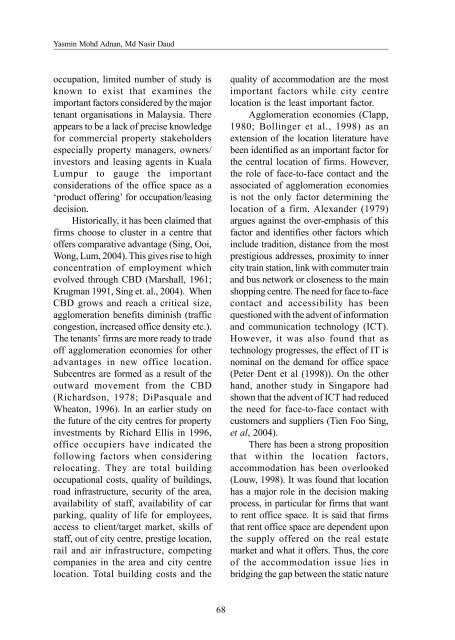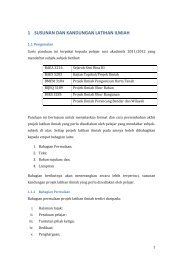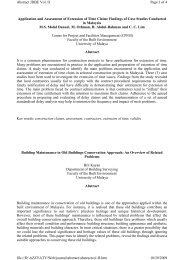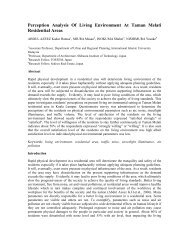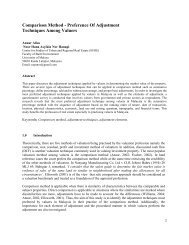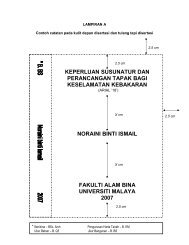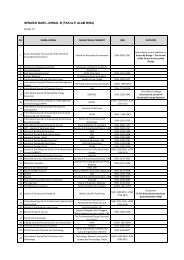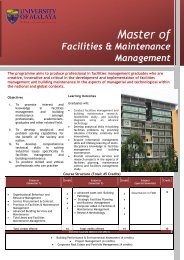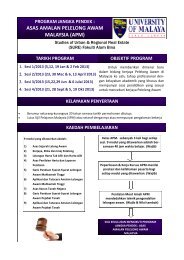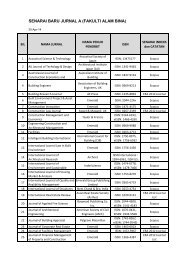Factors Influencing Office Building Occupation Decision by Tenants ...
Factors Influencing Office Building Occupation Decision by Tenants ...
Factors Influencing Office Building Occupation Decision by Tenants ...
You also want an ePaper? Increase the reach of your titles
YUMPU automatically turns print PDFs into web optimized ePapers that Google loves.
Yasmin Mohd Adnan, Md Nasir Daudoccupation, limited number of study isknown to exist that examines theimportant factors considered <strong>by</strong> the majortenant organisations in Malaysia. Thereappears to be a lack of precise knowledgefor commercial property stakeholdersespecially property managers, owners/investors and leasing agents in KualaLumpur to gauge the importantconsiderations of the office space as a‘product offering’ for occupation/leasingdecision.Historically, it has been claimed thatfirms choose to cluster in a centre thatoffers comparative advantage (Sing, Ooi,Wong, Lum, 2004). This gives rise to highconcentration of employment whichevolved through CBD (Marshall, 1961;Krugman 1991, Sing et. al., 2004). WhenCBD grows and reach a critical size,agglomeration benefits diminish (trafficcongestion, increased office density etc.).The tenants’ firms are more ready to tradeoff agglomeration economies for otheradvantages in new office location.Subcentres are formed as a result of theoutward movement from the CBD(Richardson, 1978; DiPasquale andWheaton, 1996). In an earlier study onthe future of the city centres for propertyinvestments <strong>by</strong> Richard Ellis in 1996,office occupiers have indicated thefollowing factors when consideringrelocating. They are total buildingoccupational costs, quality of buildings,road infrastructure, security of the area,availability of staff, availability of carparking, quality of life for employees,access to client/target market, skills ofstaff, out of city centre, prestige location,rail and air infrastructure, competingcompanies in the area and city centrelocation. Total building costs and thequality of accommodation are the mostimportant factors while city centrelocation is the least important factor.Agglomeration economies (Clapp,1980; Bollinger et al., 1998) as anextension of the location literature havebeen identified as an important factor forthe central location of firms. However,the role of face-to-face contact and theassociated of agglomeration economiesis not the only factor determining thelocation of a firm. Alexander (1979)argues against the over-emphasis of thisfactor and identifies other factors whichinclude tradition, distance from the mostprestigious addresses, proximity to innercity train station, link with commuter trainand bus network or closeness to the mainshopping centre. The need for face to-facecontact and accessibility has beenquestioned with the advent of informationand communication technology (ICT).However, it was also found that astechnology progresses, the effect of IT isnominal on the demand for office space(Peter Dent et al (1998)). On the otherhand, another study in Singapore hadshown that the advent of ICT had reducedthe need for face-to-face contact withcustomers and suppliers (Tien Foo Sing,et al, 2004).There has been a strong propositionthat within the location factors,accommodation has been overlooked(Louw, 1998). It was found that locationhas a major role in the decision makingprocess, in particular for firms that wantto rent office space. It is said that firmsthat rent office space are dependent uponthe supply offered on the real estatemarket and what it offers. Thus, the coreof the accommodation issue lies inbridging the gap between the static nature68


